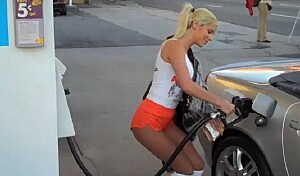
The largest filling station networks in Europe (2017)
In Argentina, as of 2014, there are 3,916 stations after a 2% decrease from the previous year. Russia-there were about 25,000 stations in the Russian Federation (2011). In China, according to different reports, the total number of gas/oil stations (at the end of 2018) is about 106,000. In Germany, the number dropped down to 14,300 in 2011. In Japan, the number dropped from a peak of 60,421 in 1994 to 40,357 at the end of 2009. As of December 2008, 12,684 were in operation, significantly down from about 20,000 stations recorded in 1989. In Canada, the number is on the decline. The US had 114,474 stations in 2012, according to the US Census Bureau, down from 118,756 in 2007 and 121,446 in 2002. The UK has 8,385 filling stations as of 2019, down from about 18,000 in 1992 and a peak of around 40,000 in the mid-1960s. In Japanese, a commonly used term is gasoline stand although the abbreviation SS (for service station) is also used. In India, Pakistan and Bangladesh, it is called a " petrol pump" or a " petrol bunk". Similarly, in Australia, New Zealand, the United Kingdom, and Ireland, the term " service station" describes any petrol station Australians also call it a " servo". In the United Kingdom, Ireland, New Zealand and South Africa " garage" and forecourt is still commonly used. In the rest of the English-speaking world the fuel is known as "petrol", and the term " petrol station" or " petrol pump" is used. In some regions of Canada, the term " gas bar" (or "gasbar") is used. In North America the fuel is known as "gasoline" or "gas" for short, and " gas station" and " service station" are used in the United States, Canada, and the Caribbean. 

8 Other goods and services commonly available.

2.1 The largest filling station networks in Europe (2017).Conversely, some chain stores, such as supermarkets, discount stores, warehouse clubs, or traditional convenience stores, have provided fuel pumps on the premises. Some also sell propane or butane and have added shops to their primary business. Many filling stations provide convenience stores, which may sell confections, alcoholic beverages, tobacco products, lottery tickets, soft drinks, snacks, coffee, newspapers, magazines, cheap sunglasses, and, in some cases, a small selection of grocery items, such as milk. Besides fuel dispensers, one other significant device which is also found in filling stations and can refuel certain (compressed-air) vehicles is an air compressor, although generally these are just used to inflate car tires. The most common fuels sold in the 2010s were gasoline (or "petrol") and diesel fuel.įuel dispensers are used to pump gasoline, diesel, compressed natural gas, CGH2, HCNG, LPG, liquid hydrogen, kerosene, alcohol fuel (like methanol, ethanol, butanol, propanol), biofuels (like straight vegetable oil, biodiesel), or other types of fuel into the tanks within vehicles and calculate the financial cost of the fuel transferred to the vehicle. Pre-fabricated gas station, Culver City, California, US 1977Ī filling station, also known as petrol station or gas station (US), is a facility that sells fuel and engine lubricants for motor vehicles.







 0 kommentar(er)
0 kommentar(er)
